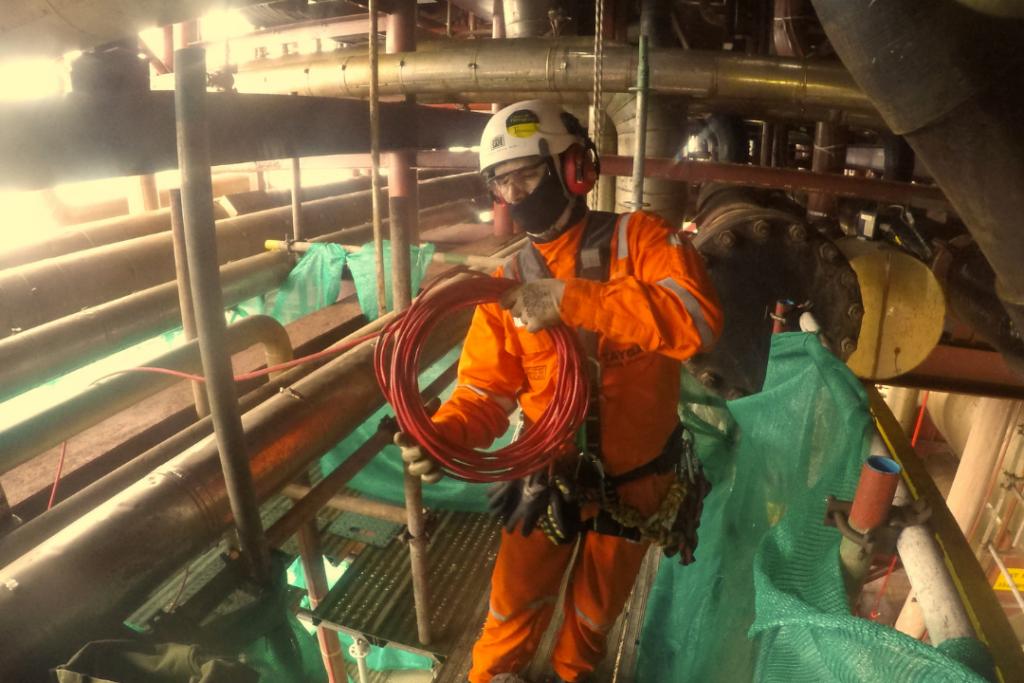Errors in electric trace sizing can compromise industrial efficiency and safety. Discover the main misconceptions, as a subdimensions, Failures at critical points and inadequate choice of materials, besides strategies to avoid them. Tayga applies precision engineering to ensure optimized projects, safe and efficient.
The correct sizing of an electric trace system is critical to ensure thermal efficiency, operational safety and energy saving in industrial processes. However, errors in the design phase can compromise system performance, generate waste and significantly increase maintenance and rework costs.
In this article, We approach the most common errors in electric trace sizing and best practices to avoid them, ensuring an efficient and aligned project with industry needs.
1.SYSTEM SUBDIMENSION
Problem:
Sub -dimensioning occurs when the power of the electric trace is insufficient to meet the thermal demand of the process. This can result in temperatures below the necessary, affecting fluid viscosity, the operation of chemical processes and even causing freezing pipes in cold environments.
Common causes:
- Incorrect calculation of thermal losses.
- Use of cables with inadequate power.
- Lack of consideration of environmental variables such as wind, humidity and extreme temperatures.
How to avoid:
- Perform detailed calculations of thermal losses considering isolation, ambient temperature and process requirements.
- Choose cables with enough power to compensate for heat losses and maintain the desired temperature.
- Use engineering tools and software to simulate different scenarios and validate sizing.
2. Electric trace superdimensioning
Problem:
Superdimensions leads to excessive energy consumption, may generate overheating, damage materials and increase operating costs unnecessarily.
Common causes:
- Application of power cables greater than necessary.
- Lack of fine adjustments in the definition of the thermal layout.
- Absence of adequate control by sensors and thermostats.
How to avoid:
- Correctly define the power of the electric trace based on the real need of the process.
- Implement Temperature Control Systems to avoid over heating.
- Use isolating materials suitable to minimize thermal losses and optimize the use of energy.
3. Disregard of critical points (Flanges, Valves and brackets)
Problem:
Critical areas, like flanges, valves, Supports and Curves, dissipate heat more intensely and require special attention to the project. When ignored, These areas can become thermal failure points, compromising the effectiveness of the electric trait.
Common causes:
- Sizing based only on the straight pipeline stretch.
- Lack of addition of extra cables in areas with greater thermal loss.
- Inadequate installation at these points, without thermal compensation.
How to avoid:
- Previously identify the critical points of the system and calculate the need for additional power.
- Apply appropriate installation techniques, as extra bows in flanges and optimized disposition of the trace in valves and curves.
- Ensure that the installation team follows specific technical procedures for these elements.
4. Failure to select insulating materials
Problem:
Inadequate thermal insulation can compromise all the efficiency of the electric trace, increasing energy consumption and reducing system effectiveness.
Common causes:
- Choice of insulators with low thermal resistance.
- Insulation installation without adequate sealing.
- Lack of periodic inspection to verify deterioration of materials.
How to avoid:
- Select thermal insulation materials compatible with the process temperature range.
- Ensure complete sealing of isolation to avoid moisture infiltration.
- Implement a maintenance plan to regularly inspect the integrity of thermal insulation.
5. Absence of control and temperature monitoring
Problem:
The lack of an efficient control and monitoring system can lead to unexpected thermal variations, affecting the performance and reliability of the electric trace.
Common causes:
- Non -use of temperature sensors or thermostats.
- FAILURE IN CALIBRATION OF CONTROL SYSTEMS.
- Manual monitoring without use of automation.
How to avoid:
- Implement temperature sensors and automatic control systems for continuous adjustment of the power power power.
- Perform periodic calibration of control devices to maintain accuracy in adjustments.
- Adopt remote monitoring technologies to track real -time system performance.
Tayga's commitment to Precision Engineering
Na tayga, we understand the importance of correct sizing to ensure efficiency, safety and durability in electric trace systems. Our team of highly trained engineers performs detailed calculations, Using simulation software and strict methodologies to ensure that each project is sized ideally.
With personalized solutions and focus on innovation, Tayga delivers systems that avoid waste, reduce costs and guarantee maximum reliability for industrial operations.

DDiscover how Tayga heating solutions can transform your industrial operations.
Get in touch today to learn more about our services and how we can help you achieve excellence on your next project.

We are available through do site (click here) or by e-mail contato@taygahs.com or at phone and Whatsapp (21) 9.8819-3687.
We also recommend reading our materials on the heating and insulation systems implemented by Tayga (just click and you will be redirected):


